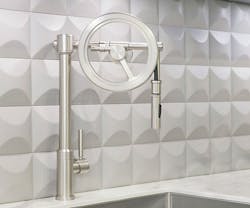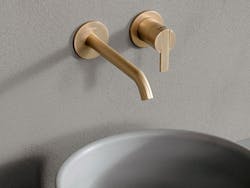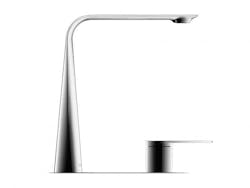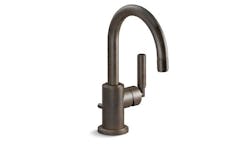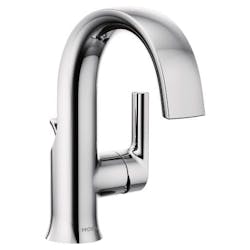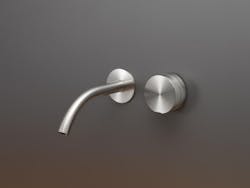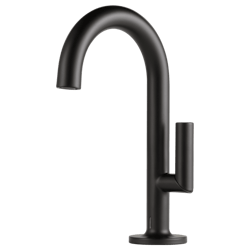5 Considerations to Help You Choose the Right Faucet
The faucet is perhaps one of the two most important elements in the kitchen and bath, and picking the right one makes a difference to homeowners. Remember these five things to help you choose wisely.
Obviously, many product categories can claim their importance in the kitchen and bath, but the faucet holds a special place. Bringing plumbing to the indoor improved the convenience and sanitary conditions for millions of Americans.
Starting around 1840, indoor plumbing was a giant leap for American households, though the transition took almost 100 years. By 1940, half of all houses still lacked hot piped water, a bathtub or shower, or a flush toilet, according to the American Council for an Energy Efficient Economy. “As late as 1960, over 25% of the houses in 16 states didn’t have complete plumbing facilities.”
Today, the kitchen and the bath revolve around access to fresh, potable water for drinking, cooking, and personal cleansing, and the faucet is king. So how do you choose a good spigot that will deliver years of worry-free performance? You do it carefully.
Here are five important things to remember:
The Code collection of stainless steel faucets combining both functionality and aesthetics. Each tap with its finishes and shapes can be adapted to any environment or piece of bathroom furniture: bathtubs, washbasins, washbasins with a column to the ground or those that are wall-mounted or mirror-mounted taps.
1. Material Matters
You can choose from a variety of materials for your faucets, including stainless steel, plastic, zinc alloys, and brass. The most preferred material is solid brass.
“Brass is an alloy of copper and zinc, and has been the most commonly used faucet material for some time,” says PlumbingSupply.com. “Solid brass faucets are renowned for their durability, and are your best bet for a high quality faucet that will last for many years (though stainless steel has an edge in corrosion resistance). Watch out for inferior brass-plated faucets, which as mentioned above will have a lower-grade metal underneath.”
Stainless steel is your next best bet. Prize by architects and design aficionados, stainless makes for a modern-looking faucet. It also results in a faucet with “superb corrosion resistance,” says PlumbingSupply.com. One tip; Avoid any faucet that doesn't use type 304 stainless steel, which has greater amounts of chromium and nickel for added strength and quality.
Plumbers and plumbing distributors say pros and their clients should also stay away from chrome-plated plastic faucets and other metal alloys. Faucets made from these materials tend to be less expensive and are suited for projects on a tight budget, but they tend to be relatively low-quality and less durable. “While metal alloy faucets can be serviceable—if short lived—option for those on a tight budget, plastic faucets should be avoided,” says PlumbingSupply.com. “This is especially so in areas with hard water; mineral deposits will wear plastic components sooner and more severely than metal.”
Designed by Matteo Thun and Antonio Rodriguez, the D.1 faucet features a fluid transition from basic cylindrical shape to a super-flat outlet. The electronic D.1e variant features the flat, circular operating button with an integrated LED color ring and offers a wide range of functions for intuitive high-end comfort and safety.
2. All About the Valve
Once upon a time, the average faucet used a compression or ball valve to control the flow of water. Using rubber washers that tend to degrade fairly quickly, compression faucets leak pretty routinely, though they are relatively easy to fix. Ball-type faucets use multiple parts, each of which are potential points of failure, PlumbingSupply.com says.
Most manufacturers today use a far more reliable cartridge system, and the best for long-term performance and durability is the ceramic disc cartridge.
“Ceramics are known for their long-term reliability,” Orange Coast Plumbing says. “Now that ceramic valves are being incorporated in different types of contemporary faucets, drips and leaks are becoming a thing of the past. There’s no reason not to choose a faucet with a ceramic valve, even if you’re on a limited budget. They are priced slightly higher than basic faucets, but reliability and low maintenance cost are two things you can’t put a price tag on.”
Designed by Laura Kirar, the Vir Stil Minimal single-control faucet features solid-brass construction for durability and reliability and ceramic valves. Dual application means it can be used in the bathroom or in the kitchen as a bar faucet.
3. Choose a Tough Finish
Polished chrome is and always has been the top choice for faucets, but satin nickel and bronze finishes are also top getters. Still, some finishes are more durable than others. Chrome is good-looking, but it shows fingerprints. For truly high performance finishes, look for PVD options. These use physical vapor deposition (PVD) to bond the finish and faucet together at the molecular level, creating an incredibly strong surface that is scratch- and tarnish-resistant.
“This process uses vacuum pressure and electric charge to create a much stronger bond between faucet and finish,” PlumbingSupply.com says.
The Doux Collection single-handle faucet offers a graceful arc and unique, soft-stream water flow. It has a D-shaped spout that was carefully crafted to present the water in a flat, thin silky ribbon to continue the clean lines of the faucet’s smooth, wide form, the company says. It comes in three finishes.
4. Live the Single (Handle) Life
For some, two-handle widespread faucets strike a stylish pose in the bath, but for functionality, nothing beats the single-handle faucet. They are more practical, and easier to use and clean.
“Single-handle faucets are ideal for the minimalist or the home chef that prizes efficiency,” says Pioneer Industries, parent company of the Olympia, Pioneer, and Central Brass faucet brands. “Offering a more sleek look for the modern kitchen, single-handle faucets take up much less counter space, require less counter drilling, and let you adjust temperature and flow with ease. It’s little wonder why these faucets continue to grow in popularity.”
An extension of the brand’s Giotto Collection, the Giotto Plus line is made of stainless steel and draws inspiration by the archetypal forms of the circle. It comes Products are available in the standard satin and polished finish and in all CEA’s special finishes (Black Diamond, Bronze, Copper and Light Gold).
5. Get on the Wall (if your client is adventurous)
For forward-thinking designers and their clients, installing a faucet on the countertop is old news; wall-mount is the choice.
Found increasingly in modern bathrooms and kitchens, the faucets are ideal for vessel sinks, but they are also perfect for undermount sinks. The units are tricky to install and require plumbing alterations or a different rough-in, but they are easier to use, easy to clean, and creates space on the countertop. Bonus: They look really really cool.
"Since you’re dealing with water, soap, and dirt being washed away, you can expect deposits to accumulate and make the area behind the faucet look unkempt," Los Angeles and San Jose, Calif.-based Wise Builders writes on its website. "Sink-mounted faucets are usually difficult to clean, however, wall-mounted faucets aren’t so hard. Since there’s no hardware causing an obstruction, it is easier to maintain."
